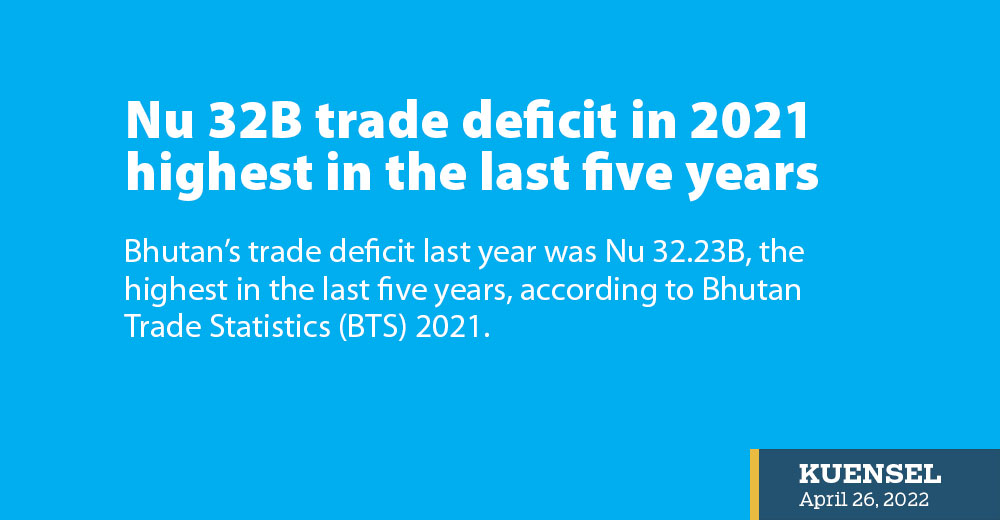Dechen Dolkar
Bhutan’s trade deficit last year was Nu 32.23B, the highest in the last five years, according to Bhutan Trade Statistics (BTS) 2021.
A trade deficit is an economic measure of a negative balance of trade, where imports exceed exports and a country’s import value is greater than its export.
The country exported goods worth Nu 57.99B and imported goods worth Nu 90.22B in 2021.
A trade deficit is the largest component of the current account deficit as it includes both trade balance and balance of payments, which is the sum of all transactions between a nation and all of its international trading partners.
Import
The import value increased drastically from Nu 66.63B in 2020 to Nu 90.22B last year.
Imports from India increased by 39.13 percent and other countries by 24.47 percent as compared to 2020.
Officials from the finance ministry claimed the increase in imports last year could be a sign of economy recovery where there is an increase in import of raw materials, equipment and consumables.
“It could also be because of regulated imports,” an official said. “Before the pandemic, due to porous borders and free movement across the border, there were imports that were not declared to customs.”
The official explained that all imports are now regulated through the mini dry port, irrespective of value or size.
Officials also said that it could be because of better coordination and facilitation of imports at the point of entries in 2021 as compared to 2020 as they learnt to adapt to the new normal.
They said processing units and storage units by the ICT sector, fossil fuels (Petrol and Diesel), raw materials for Pasakha industries and pharmaceutical products are some of the items that caused the increase in imports value.
Bhutan imported diesel worth Nu 6.38B and petroleum worth Nu 2B last year.
Record also showed rice was one of the top ten import commodities, amounting to about Nu 2.18B expenditure.
Most of the items were imported from India, China, Singapore, Thailand and Bangladesh last year.
Export
According to the report, the export figure has also increased gradually over the years. Export for 2021 has increased by 61.85 percent than 2020.
Ferrosilicon is still the top commodity Bhutan exported in 2021 with Nu 15.28B. The export value of ferrosilicon has increased over the years. In 2020, Nu 7.44B worth was exported and in 2019, its export was worth Nu 9.78B.
Finance ministry officials said there was more than 100 percent increase in export of ferrosilicon last year with an increase in terms of quantity exported as well as an increase in price of ferrosilicon.
The average unit price for 1kg of ferrosilicon increased from Nu 76.81 in 2020 to Nu 122.13 last year.
Officials said there was also an increase in export of ferrosilicon manganese from Nu 106M in 2020 to Nu 2.27B in 2021.
“There was also an increase in export of mineral products from Nu 6.70B in 2020 to Nu 9.86B in 2021 showing an increase of 47.16 percent,” an official said.
Boulder was the second most exported Bhutanese product in 2021 with the value of Nu 2.48B. However, the boulder export has decreased from 2019. In 2020, Bhutan exported boulders worth Nu 1.87B and Nu 4.97B in 2019.
Last year, there was an increase in export of cardamom from Nu 1.01B in 2020 to Nu 1.71B.
Meanwhile, electricity export played a crucial role in narrowing the trade deficit, according to the report.
It stated that had it not been for electricity export, the country’s trade deficit could hover around Nu 56.67B in the red.
“Bhutan’s trade balance with India is Nu 20.39B. It imported Nu 71.23B worth of goods from India and exported Nu 50.84B last year including electricity,” the report stated.
Energy export last year was 8,075.50 million unit (MU) and earned Nu 24.43B compared to that of 9,206.58MU and earning of Nu 27.52B in 2020.
India, Bangladesh, Italy, Nepal and China were the top export destinations.
Exporters said they could not export as usual in 2020 due to a prolonged lockdown in Bhutan as well as in India.
”The export couldn’t begin as expected and the pandemic disrupted the trade,” an official said.
They also said they were not able to export for six months last year and they exported only when the containment mode was started.
In 2020 and 2021, boulder export was halted several times due to lockdown in the border areas.


